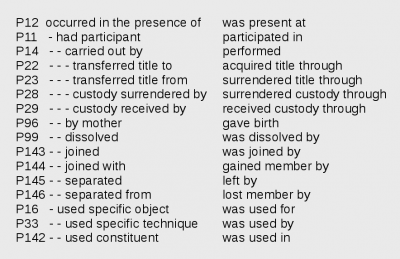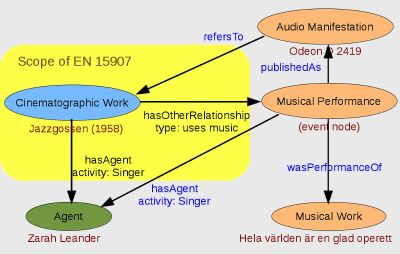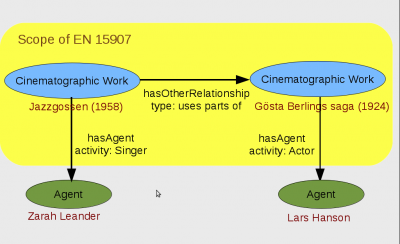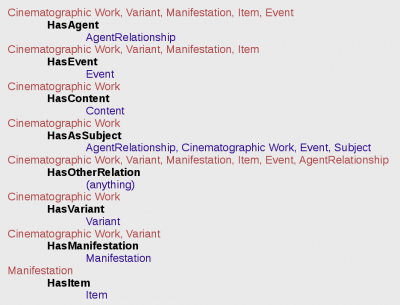Relationships: An essential component of art and culture
From filmstandards.org
From the TC 372 Workshop Compendium
Giving spice to metadata
Why do we add something to a collection of an archive, a museum, or a library? We do not add something because it weighs 3.5 kilograms, is of blue color, or is made of cardboard. We rather add it because it relates to something we know, and possibly, to other things in ways we still have to discover.
 http://commons.wikimedia.org/wiki/File:2006-10-15_Tasse%2BUntertasse-Pflaume01.jpg |
Trash or treasure? It all depends on relationships. Who drank from this cup? Was it someone important? Who was the previous owner? Is it a rare specimen or does it exist in thousands of exemplars? Who created the design and who manufactured it? Is it a specimen of an important artistic style? And perhaps most importantly: was it used in the set decoration for a film? |
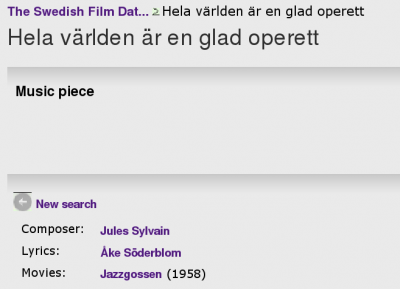 From: http://www.sfi.se/en-gb/Swedish-film-database/Item/?type=MUSIC&itemid=1688 |
Here is a record for a musical work as part of a filmographic database. EN 15907 defines a HasOtherRelation element that can be used to relate cinematographic works to non-film works such as music. |
| • • • |
Relationships and the Web
Cultural heritage studies consist to a large part in elucidating relationships. To date, the World Wide Web has only been marginally useful for transforming relationships from printed prose into a navigable data space. To a machine, a hyperlink is just a jump target that leads from one document to another in an unspecified way. Can we do better?
 From: Tim Berners-Lee and Daniel Connolly: Hypertext Markup Language. Internet Draft, 1993. http://www.w3.org/MarkUp/draft-ietf-iiir-html-01.txt |
Initially, in 1993, the Hypertext Markup Language (HTML) was designed with elements that would allow computers to distiguish between e.g. author, address, content, etc., and even between different kinds of links. As the Web began to grow, this idea did not catch on and HTML was used primarily as a text formatting language. It took another decade before the idea of semantic tags and links started to spread. |
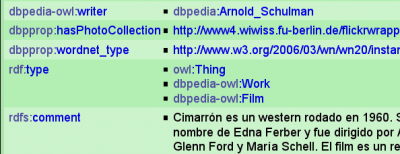 From: http://dbpedia.org/page/Cimarron_%281960_film%29 accessed 12-Oct-2010 |
In 2009, the World Wide Web Consortium (W3C) started introducing a new facility for semantic linking in conjunction with version 5 of the HTML specification. Termed RDFa, this HTML extension allows for expressing relationships according to the RDF data model. RDF is designated as the backbone for most of what is becoming known as the semantic web. Marked up using RDFa, factual statments can be extracted from text such that they can be transformed, queried, or used in inference chains. |
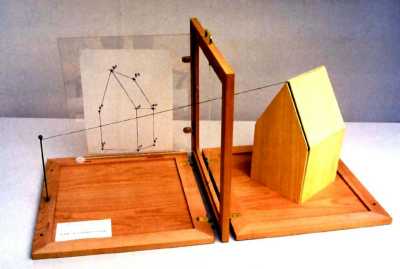 "Modell zum Durchstoßverfahren der Perspektive nach Brunelleschi, gebaut nach den Darstellungen von Albrecht Duerer". http://www.aida.uni-hannover.de/aida/max/70~Forschung/Darstellungsgrundlagen/ |
Apart from telling what different things have to do with each other, relationship statements are also used to explain the degree and kind of similarity between things. Similarity relationships are known as mappings, a term borrowed from mathematics. The activity of establishing such relationships is sometimes referred to as matching. |
| • Previous: Events in the lifecycle of an audiovisual creation • Up: Contents • Next: No entity without identity • |
